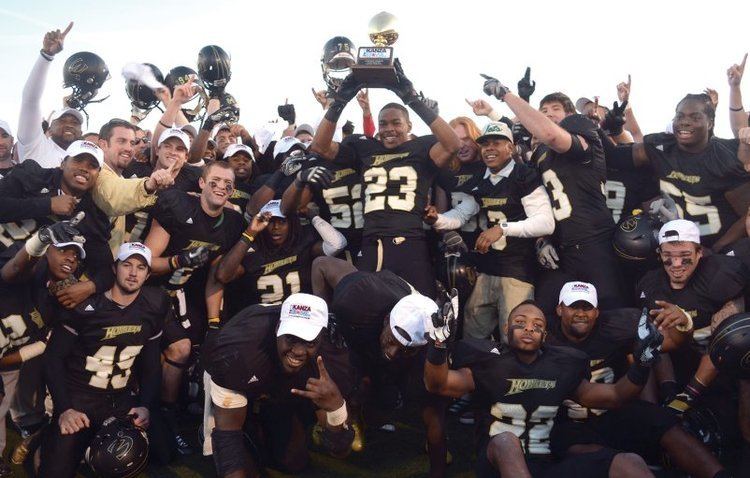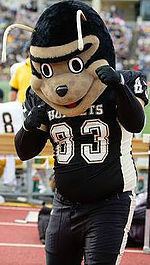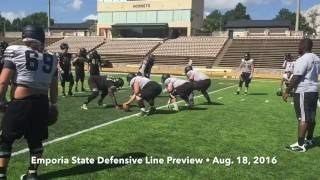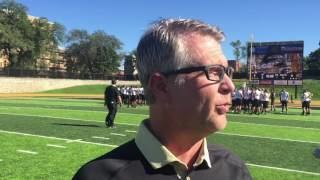First season 1893 (1893) Year built 1937 Field surface Artificial Colors Black, Gold | Field Jones Field Seating capacity 10,000 | |
Rival Washburn Ichabods football | ||
The Emporia State Hornets football program is a college football team that represents Emporia State University, often referred to as "Emporia State" or "ESU". The team competes as a member of the Mid-America Intercollegiate Athletics Association (MIAA), which is a conference in the Division II of the National Collegiate Athletic Association (NCAA). The program began in 1897 and has fifteen conference titles. On December 15, 2006, former Hornet quarterback Garin Higgins became the team's 24th head coach, following the resignation of Dave Wiemers. Home games are played on Jones Field at Welch Stadium, located on the Emporia State University campus in Emporia, Kansas.
Contents
- History
- Early history 18931927
- Fran Welch era 19281942 19461954
- Caywood era 19551966
- Blaylock Lance and Elliott eras 19671974
- Hoover and Seaman eras 19751982
- Larry Kramer era 19831994
- Manny Matsakis era 19951998
- Jerry Kill era 19992000
- Dave Wiemers era 20012006
- Garin Higgins era 2007present
- Conference championships
- Stadium
- Silent Joe
- School colors
- Mascot
- Coaching staff
- Notable players
- References

History
The most successful era for ESU football was from 1928 to 1954, when the program was coached by Fran Welch and posted an overall .578 winning percentage. From 1955 to 1982, the Hornets struggled to find success on the football field, as the team's overall winning percentage during that era slipped to .295 (74–182–8).
From 1983 through the 2013 season, ESU's winning percentage increased to .537 (182–157–0), and all five coaches at ESU during this era have either a winning record or a tied record. During the 2012 season, the Hornets competed in a postseason game for the first time since 2003 and placed second in the conference.

Until the 1930s, the Kansas State Normal/Kansas State Teachers College (now Emporia State University) didn't have an athletics nickname. In the early 1930s, the athletic teams were then known as the "Yaps". However, many people were not fond of the name, most notably legendary coach, Vic Trusler. Trusler suggested to a local writer, Cecil Carle of the Emporia Gazette, that the university's athletic teams should be called the "Yellow Jackets" but instead, the name was changed to "Hornets" due to the lack of newspaper space.
Early history (1893–1927)

The Kansas State Normal School (KSN), now known as Emporia State University, fielded its first football team in 1893, which had no coach. In 1893, KSN played the College of Emporia, which KSN won 14–0 and lost 0–24 against the Ottawa Braves. After playing six abbreviated game seasons, KSN played its first full schedule in 1899 and had a 2–3–0 record under no head coach. The 1899 football season was the first of the "Turnpike Tussle" series, which is played between the Hornets and the Washburn Ichabods.

In 1900, John Lamb served one season as KSN's football coach, posting the first winning season in school history (5–3–1). After Lamb's season, Northern Iowa's coach Fred Williams, who later was an attorney, came to KSN from to serve as head coach, but struggled to a 2–6–1 record in his only season in 1901. The 1902 season featured the program's second–only game of its rivalry against Washburn, a 0–6 Hornet loss.
The program had eight head coaches from 1900–13, but in 1914, Bill Hargiss took the position in 1914. He held it for the next three highly successful seasons, through 1917, and then again from 1920–27. Hargiss' overall coaching record at KSN/KSTC was 61–23–11. Hargiss is the only head coach in school history to have an undefeated season and puts him third at the school in terms of winning percentage (.700). Hargiss' best seasons were the 1921 and 1926 seasons, when the Normals/Teachers posted an undefeated season and outscored their opponents 144 to 3. The closest game of the season was a 6–0 battle against Hargiss's former team, the College of Emporia. ESU has not had another undefeated season since 1926.
In the 1918 and 1919 seasons, KSN had two unsuccessful coaches, H. D. McChesney with a 2–2–0 (.500) record, and George McLaren with a 1–6–2 .222 record.
Fran Welch era (1928–1942, 1946–1954)
KSN alum Fran Welch was hired by his alma mater as the 13th head football coach in 1928, taking over after Bill Hargiss left for the University of Kansas. Welch led the Teachers to a 7–0–1 record during his first season.
In the 1932 and 33 seasons were a low season for the Yaps, as they went to 5–11–2. From 1934 until 1942, the Hornets had some winning seasons, and losing seasons. Because of WWII, the Hornets did not field a team from 1942–45. In the return season of 1946, the Hornets went 4–5; however, in 1947, the Hornets turned things around, leading the 1948 team to a 34–20 win over Southwest Missouri State University at the Missouri-Kansas Bowl. In the next five out of six seasons, the Hornets won five conference championships.
Not only did Welch finish his career as the most successful coach in ESU History, but he finished with 7 conference championships and one bowl game, leading to an overall record of 115–82–15 (.578) during his 26 years as head coach.
Caywood era (1955–1966)
In 1955, KSTC hired Keith Caywood as the 14th head football coach of KSTC. In his 12 years as head coach at KSTC, he only had one winning season; in 1958, the Hornets went 5–4–1, which included a 0–21 loss to Lincoln (MO) at the Mineral Water Bowl. In 1966, Caywood resigned as head coach posting an overall record of 25–79–5 (.252).
Blaylock, Lance, and Elliott eras (1967–1974)
From 1967 until 1970, the Hornets continued to struggle. In 1967, Ron Blaylock became the 15th head coach for the Hornets, going 1–9–0 in his first season. Blaylock resigned after two seasons in 1968, ending with an overall record of 6–11–2 (.368). In 1969, Jim Lance was hired as the 16th head coach and much like Blaylock, was unsuccessful. In 1970, he resigned with a record of 6–12–0 (.353).
After nearly two decades of being unsuccessful, KSTC hired Harold Elliott as the 17th head coach in hopes that he could rebuild the program. In 1971, his first season, he led the Hornets to a 3–6–1 record, but turned things around in the 1973 season, he went on to a 7–4–0 record, winning the conference championship and a 14–17 loss to William Penn at the Boot Hill Bowl. He repeated the conference championship in 1974 with a 7–2–0 record. Elliott left KSTC to become the head coach at the University of Texas at Arlington, leaving KSTC with a 17–11–1 (.603) record.
Hoover and Seaman eras (1975–1982)
For the next nine seasons, Emporia State continued to decline. Dave Hoover became the 18th head coach at ESU, with an overall record of 9–40–0 (.184). After Hoover was let go, Bob Seaman became the 19th head football coach for Emporia State University in Emporia, Kansas and he held that position for four seasons, from 1979 until 1982. His overall coaching record at Emporia State was 10–30.
Larry Kramer era (1983–1994)
After nearly three decades of being unsuccessful, Larry Kramer became the 20th head coach of Emporia State. In his first two season at ESU, he posted a record of 5–15, but in 1985, he turned the team around and posted a record of 6–4. In 1987 and 1988, Kramer led the Hornets to the NAIA post-season playoffs, which included two losses. In 1989, Kramer led the team to a conference championship and two NAIA playoff games, which led to the NAIA Division I National Championship game, in which they lost 20–34 to Carson-Newman University of Jefferson City, Tennessee. From 1990 until his resignation in 1994, the Hornets posted a record of 26–24–0. Kramer resigned after the 1994 season to become an assistant coach for the Kansas State WIldcats, leaving ESU with an overall record of 71–54–0 (.568).
Manny Matsakis era (1995–1998)
The 21st head football coach for the Hornets was Manny Matsakis. During Matsakis' four years, the Hornets went 27–17–0 (.614). After the 1998 season, Matsakis left Emporia State to be an assistant for the University of Wyoming.
Jerry Kill era (1999–2000)
Jerry Kill became the 22nd head football coach for Emporia State in 1999. In his first season, the Hornets went 5–6–0, but in his last season in 2000, the Hornets went 6–5–0. After the 2000 season, he left with a tied record of 11–11–0 (.500) to be the head coach at the Southern Illinois Salukis. Kill was most recently the head coach for the Minnesota Golden Gophers.
Dave Wiemers era (2001–2006)
Dave Wiemers took the helm as the 23rd Hornet football coach in 2001, replacing Jerry Kill. Although the Hornets were unsuccessful in his first season going 5–6, Wiemers led the Hornets to a 9–2 season in 2002 and a trip to the Mineral Water Bowl, which they won in overtime 34–27 against Winona State. In 2003, the Hornets won a co-conference championship and made their first–ever trip to the NCAA Division II playoffs, losing to Winona State 3–10. Following those two successful seasons, the Hornets declined and failed to have a winning season. Between 2004 and 2006, the Hornets posted a combined record of 12–20–0. Wiemers resigned on November 16, 2006, leaving Emporia State with a record of 35–32–0 (.522).
Garin Higgins era (2007–present)
In December 2006, former Hornet quarterback Garin Higgins became the team's 24th head coach, following the resignation of Dave Wiemers. With a record of 19–36 (.345) in his first five seasons, Higgins struggled to bring the Hornets to a winning record. Things changed however, in 2012 when the Hornets posted a 10–2–0 record, placing second in the conference and winning a trip to the Kanza Bowl, outscoring the Texas A&M–Kingsville Javelinas 45–38. In 2013, the Hornets earned a play–off spot in the NCAA Division II playoffs. The Hornets played the Minnesota–Duluth Bulldogs, losing 13–55. As of March 9, 2017, Higgins has a record of 64–52 (.552).
Conference championships
Source:
Stadium
Francis G. Welch Stadium serves as home to the Hornets football team. The stadium, which is named for long–time Emporia State football coach and athletic director Fran Welch, opened in 1947 and since then has gone under a few renovations. In 1994, the east and west side concession areas, restroom facilities, and entrances were renovated, a new scoreboard was hoisted into place at the south end of the stadium and a new landscaped fence was erected. In 1997, the Hutchinson Family Pavilion, a three–tiered facility which has enclosed theatre seating on the first floor, a president’s box and four sky–boxes on the second floor, and a game–day management and media center on the third floor was built. The current seating capacity is 7,000.
Silent Joe
The bell tower adjacent to the football stadium is known as "Silent Joe." The bell, which weighs approximately 1,400 pounds, was first used in 1855 and hung in the original KSN administration building until 1880.
In 1880 when the former administration building was razed, the bell was kept in storage until the present bell tower was completed in August 1939. The plan was for the bell to be rung only after a school victory. The 1939 Hornet football squad was expected to be a “superteam.” Some optimists speculated the bell would be worn out halfway through the season, but after the first two games that season, the contrary became apparent. After that, the bell was known as “Silent Joe.” The name “Joe” was chosen because it was a common label for male students then.
School colors
Emporia State's official school colors are black and gold. They have been the colors since the school was founded in 1863, and until recently, the gold was Old gold.
Mascot
Corky the Hornet is Emporia State University's mascot. In 1923 when the Emporia State was named to the Kansas State Teachers College, the athletic teams were known as the "Yaps". Many people not like the name, most notably Emporia State coach Vic Trusler. Trusler suggested to Cecil Carle of the Emporia Gazette that the university's athletic teams should be called the "Yellow Jackets". However, the name changed to "Hornets" due to the lack of newspaper space.
In 1933, the Teachers College had a student contest where students and staff could design a mascot for the college. Sophomore Paul Edwards, who graduated in 1937, designed Corky. Although hundreds of drawings were submitted, Edwards' Corky, a "human-like" hornet was selected. Corky was published in The Bulletin, the student newspaper for Emporia State University.
Coaching staff
Along with Higgins, there are 10 assistants.
